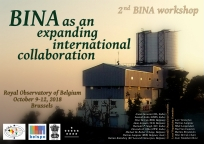Speaker
Dr
Gilles Orban de Xivry
(University of Liège)
Description
Adaptive optics (AO), by compensating in real time the blurring due to atmospheric turbulence, improves the angular resolution and the sensitivity of ground-based telescopes. AO represents an opportunity for medium size telescopes to be competitive with respect to large and very large observatories, either by being highly automatized and allowing high-yield surveys to be undertaken, or by providing very high correction up to visible wavelengths. More generally, AO can be beneficial for most scientific cases and - we think - reachable with a moderate effort investment. In this contribution, I will present the expertise we are currently building up in Liège with the SALTO project, a 1-m telescope with laser guided adaptive optics system. I will then focus on two different sciences cases, discuss how they would drive the design of the AO system, and the general benefit that AO would bring to the 3.6-m Devasthal Optical Telescope (DOT).
Primary author
Dr
Gilles Orban de Xivry
(University of Liège)
Co-authors
Dr
Olivier Absil
(University of Liège)
Dr
Vincent Moreau
(AMOS)

